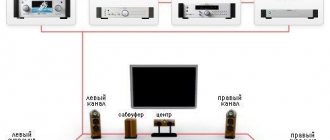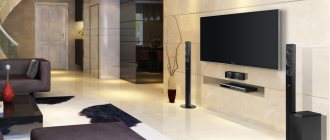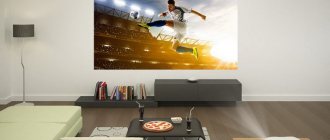A theater, as you know, begins with a hanger, and a serious home theater begins with the requirements for its construction. These requirements can be expressed in numerical values (many parameters are indicated in the standards), but first I propose to define two simple rules for high-quality recreational cinema: 1) The viewer should not see anything other than what is happening on the screen, 2) The viewer should not hear anything other than the soundtrack of the film .
Their implementation guarantees maximum “immersion” for the viewer when watching, because all his attention will be directed to what is happening on the screen, nothing will distract him.
I will return to these rules more than once when describing various aspects of creating a recreation center, but now I will start with the first stage - the stage of building the premises. Under ideal conditions, it is at this stage that the future characteristics of the home theater should be determined.
So, choosing the optimal premises for a recreation center begins, oddly enough, with the budget. The size of the screen depends on the area of the selected room, and the brightness of the projector and the distance to the audience depend on its diagonal, and these distances are important to take into account when choosing speaker systems, because the speakers must produce sound pressure with a margin for sound attenuation on the way to the listener. It is clear that the brightness of a projector greatly affects its price, in turn, acoustics capable of producing high sound pressure are also not cheap and, moreover, require powerful and expensive amplifiers.
Finally, high sound pressure requires increased attention to the quality and accuracy of the acoustic treatment of the room. And so the dependence of the price of a recreation center on the area is non-linear, and if we take acoustic treatment, then the complexity increases in the cube, because if the area doubles, the area of the treated surfaces will increase 8 times! However, according to my observations, the optimal room area for a high-class recreation center for 2-5 seats is 50-80 sq.m. with a ceiling height of 2.5-4 meters.
Isolate and absorb
Acoustic treatment of premises traditionally solves two problems: sound absorption and sound insulation.
In the case of a home theater, with the desired balance of sound absorption in the room, a correct, standard acoustic environment is formed, which significantly reduces the harmful effect of the room on sound (reflections) and creates an acoustic atmosphere similar to that in the recording studio where post-processing was carried out. Those. Ideally, we should hear everything the same and in the same way as the sound engineer heard during the final viewing before the film was released. (For now, we do not take into account issues of the quality of amplification, decoders, speakers, etc.) It is clear that every sound matters - it is not accidentally introduced into the film track, its identical reproduction will give a better understanding of the director’s idea and will ensure the correct artistic perception of the film.
In turn, sound insulation is a significant reduction in external noise penetrating into the home theater. A better signal-to-noise ratio means a wider dynamic range, and the latter is directly related to the realism of perception. Soundproofing, in addition, prevents the viewer from hearing other extraneous sounds from other rooms that will distract him from watching. Finally, there's the matter of protecting the rest of the house from the sounds of a home theater running at full power.
In addition to soundproofing the room itself, a separate task is to muffle various equipment: air conditioners, powerful amplifiers with humming transformers, a projector, etc. A particularly noisy projector is often placed in a separate box, the components are placed in a specially designated cabinet or even a separate equipment room. At the same time, the equipment indicators, again, will not distract the viewer.
TV or projector, which is better?
It's not just about your personal preferences. But also in the conditions in which your home theater will operate.
In addition to price characteristics, there are several fundamental points that fundamentally distinguish a projector from a large TV.
The main advantages and disadvantages of the projector and TV:
- A projector is much more mobile than a TV; it can be easily installed and assembled by one person. A TV with a diagonal of about two meters (eighty inches) will weigh more than thirty kilograms.
- The projector will only function fully in a completely darkened room; you will have to think about installing tightly closed doors and light-proof curtains, otherwise you simply will not see a high-quality image.
- The TV does not need such complications, and you will not have to further refurbish the room.
- The projector can be used for “open” film screenings in the fresh air. Even without lifting the screen, you can project the image onto any surface.
- With a TV, such “tricks” will definitely not work.
- The price of a TV with a diagonal of up to one and a half meters (sixty inches) will be approximately eight hundred euros, but starting at sixty-five, there is a sharp jump, and prices start at five thousand euros.
- A very good projector will cost you about three thousand euros.
Let's compare a large TV and a projector from the same manufacturer:
In the basement
The best place for a recreation center in the house is the basement. It’s easy to darken such a room (don’t forget about the illuminated sign with the inscription “Entrance”, illumination of the floor and steps), natural sound insulation immediately solves almost all the problems of sealing the room, the only questions that remain are the air supply through the ventilation ducts, doors and ceiling. To reduce the noise level outside such a recreation center, special configurations of muffled ventilation ducts and soundproofing doors with a vestibule are used.
However, there are also unobvious problems with placing a cinema in the basement. For example, due to the fact that almost all materials used for acoustic treatment have excellent thermal insulation characteristics, we will get a “thermos”, while a good DC can have a thermal output of several kilowatts. In other words, the issue of cooling a recreation center in the basement should be taken as seriously as possible. I have seen projects where the viewing temperature rose so quickly that it was difficult to be there half an hour after the start of the film show.
The next problem with basements is that low frequencies are not absorbed by the concrete walls of the basement, but are almost completely reflected back into the room. Under such conditions, the room behaves like a high-quality resonator, and as a result, the amplitudes of parasitic resonances can exceed the useful signal by 15-20 dB! And since the low frequencies decay slowly, they continue to “play” long after the main signal has ended.
There are few effective materials for sound absorption at low frequencies, they are expensive and a lot of them are required. So, in order to effectively dampen concrete walls at frequencies below 80-100 Hz, multilayer structures will be required, the principle of operation, by the way, being similar to multilayer armor, when viscous reflective and absorbing layers alternate with each other. The viscous layer partially transmits low frequencies and simultaneously converts sound into heat (sound waves cause the material to bend and vibrate), and the absorbing layer of porous blown material dampens interlayer reflections and, in turn, converts air movement in the pores of the material into heat.
There is one universal solution for suppressing low-frequency resonances. Concrete walls are lined with double sheets of gypsum fiber board with a vibration-damping gasket between them, and the resulting cavity is filled with porous or fibrous sound-absorbing material, for example, mineral wool. Then sheets of common acoustic materials such as foam rubber, Heradesign panels, etc. are glued onto these false walls made of gypsum plasterboard. - this is already required to obtain the correct level of absorption in the mid- and high-frequency ranges. In the fight against “walking” bass, you need to pay most attention to the rear wall, where the first reflection of the sound wave coming from the front speakers and subwoofers is formed.
There is also the so-called SBIR effect (Speaker Boundary Interference Response). Its essence is that the first reflections from a nearby wall come to the viewer with some delay in relation to the direct sound, and certain frequencies are in antiphase. As a result, there is a strong dip in the frequency response. To avoid this problem, all high-class recreation centers are built on built-in acoustics, so that the speaker diffusers are in the plane of the wall, then there will be no conditions for the occurrence of the SBIR effect.
Home theater from a computer
If you can make a home theater out of a smartphone, then you can build an entire entertainment center out of a computer. A home PC allows you to connect together a game console, a stereo system and a satellite receiver. If you decide to make a home theater from a computer with your own hands, then you should be prepared for the fact that it is not so simple. First you need to collect all the necessary accessories that you will need to modify your PC:
- Personal Computer;
- TV tuner cards;
- Linux distribution;
- software.
The following is a short guide on how to make a home theater with your own hands. At home, you can create a media center from a computer only using special software, such as TiVo or MythTV. Paid software (TiVo) is much easier to install, but then you will have to pay for a subscription and additional program features, if needed. Free software will allow the user to save a lot on upgrading his personal computer, but installing it will require a little work.
Step-by-step guide to converting your PC into a home theater:
- First, you need to purchase and install a TV tuner, taking into account the performance characteristics of the processor. For example, for 2006 processors with a power of 600 MHz, you should choose a single TV tuner model Hauppauge PVR-150.
- If, in addition to the practical use of a PC, its aesthetics are also important, then it is worth purchasing an additional case for a future home theater. There are special cases for sale for HTPC (home theater computer).
- Next you need to configure the BIOS. In its configurations, you need to assign a timeout for the system in standby mode. This will save energy in the future and extend the life of your PC.
- Download and install the Linux distribution. For example, Ubuntu. It can be found on the Internet and downloaded completely free of charge.
- Reboot the system and make sure that Ubuntu recognizes the installed TV tuner.
- We install the complete MythTV software package, strictly following the installation recommendations.
- We set MythTV to start autonomously when the system is turned on.
This way you can easily and quickly assemble a home theater with your own hands. Photo, video, and audio files will now be displayed without problems on the big screen, creating a cinema atmosphere at home.
Algorithms
Recently, the so-called “active systems”, when the task of controlling room reflections is taken on by a special sound processor. It is very effective precisely in the low-frequency range, where acoustics alone do not allow achieving the desired result. In fact, they help reduce the cost of “passive” acoustic treatment of a room due to this combination, when the processor is responsible for low frequencies of 100-1000 Hz, and higher results are achieved by “architectural” methods. In my opinion, this way the best result is achieved.
Most dedicated sound processors use a parametric equalizer that is carefully tuned to suppress specific room resonances. Moreover, processors of different categories have parametric equalization, from mass models to premium ones, such as ADA, JBL Synthesis, Theta Digital and others. However, “parameters” also have their drawbacks, which limit the scope of such processing. First of all, according to its operating principle, the equalizer reduces the resonance amplitude by “cutting out” a very narrow signal band, which sometimes literally leads to the disappearance of individual notes. In addition, if used incorrectly, a parametric equalizer can easily add serious phase distortion to the system. It is difficult to set up such a system well - you need a lot of experience.
There are other types of audio processing that control room reflections with high precision. For example, processors from the French company Trinnov Audio have proprietary algorithms that suppress reflections without affecting the useful signal. The technology can be briefly described as follows: at the calibration stage, the processor measures all reflections in detail, and then mixes the same “reflections” into the main signal, but only in antiphase. The sounds cancel each other out, but the useful signal does not change.
Room question
Let me return to the “room issue”. Not everyone has the opportunity to place a home theater in the basement; moreover, the cinema room is often combined with the living room. This is not a very good option, but sometimes there are no others. Here, windows, doorways, plasterboard partition walls and furniture will interfere with obtaining a good sound picture, and, of course, it will be very difficult to obtain good sound insulation. Therefore, for a recreation center, it is better to choose a room without windows, with one door, and which has a minimum of common walls with the living premises. I note that problems with sound insulation are reduced by half if the recreation center is placed in a room on the first or last floor.
The problems of sound absorption, as in the case of a recreation center with a basement, are solved in a similar way, only here it will additionally be necessary to hang heavy light-proof curtains on the windows. Lightweight plasterboard partitions can cause serious problems with the frequency response - a dip will appear at the resonance frequency of this very partition. As a result, it will need to be further strengthened or replaced with a rigid one - brick, foam concrete, etc., in order to eliminate such phenomena.
What is a home theater in the language of home appliances?
A home theater is usually called a central unit that performs switching, decoding and general control functions. Peripherals are connected through the ports: TV, projector, speakers, disc players, etc. Home theater refers to equipment that helps put together home media playback equipment:
- TV;
- Personal Computer;
- gadgets;
- music centers;
- disc players.
Moreover, some of the equipment is duplicated. For example, a modern home theater has its own means of playing discs, and you can listen to music from a flash drive on your TV.
A home theater is a case resembling a disc player, equipped with a host of additional functions.
For example, a home theater splits stereo and mono music into streams (6 or 7), creating sound all around. As you know, in the latter case there are a number of variations, the most common being 5.1. Where 5 denotes the number of speakers - center (front), left and right front, left and right rear. By unit we mean a subwoofer. The home theater is equipped with its own speakers or the speaker system can be purchased separately.
There are actually a lot of configuration options; each piece of equipment from the unimaginable collection of household appliances has its own control panel. If first of all attention is paid to the equipment, the second step is to think about how a person can manage the home theater complex. Often, TV manufacturers produce their own home theaters, the latter's remote controls replacing two (TV and home theater). However, more often you have to buy universal control panels. Be careful, before purchasing, check with the dealer - preferably with the manufacturer - which home theater model is best used with a specific TV, acoustics, disc player, or stereo system.
In truth, it's hard to avoid duplication in a complex mess. For example, a DVD player is often unnecessary. There are cases when the music center does not understand Blu-ray, but the equipment already purchased for the home can easily play the complex format mentioned.
In this case, the home theater contains input and output ports; the list even includes a pair of microphones for karaoke. It turns out that manufacturers of music centers pay a lot of attention to the needs of users.
If you have a home set-top box, in order not to constantly switch plugs on the TV, most of the input ports on the music center are duplicated, providing an advantage. For example, the digital high-performance HDMI port supports bi-directional audio. If the channel is already occupied by a home theater, playing with the set-top box will become problematic. In the described case, the device in question is equipped with not one, and often not even two, HDMI ports, but a bunch. There are no cords included; they must be purchased separately or supplied with other equipment. It is not customary to supply home theaters with HDMI cords, but on the contrary, a similar cord is included with the TV. The manufacturer's equipment complements each other. Coincidences or dissonance between equipment from different manufacturers cannot be ruled out.
We list the full composition of home theaters along with third-party equipment:
- Acoustics 5.1.
- Home theater central unit.
- DVD player.
- TV (plasma panel).
- Personal Computer.
- Image projector.
This is not a complete list of devices. Once again, there is duplication in the system. For example, a personal computer is connected via a network cable to a TV directly or to the central unit of a home theater. In the latter case, control becomes convenient. Will the TV be able to update its firmware via home theater? The answer is individual, we recommend checking with the manufacturer. Compatible speaker systems also vary, most often 5.1, but they also sell 6.1 and 7.1. The number of outputs on the rear wall of the central unit of a home theater is equal to the number of speakers. There are standard stereo outputs. The TV sound system is turned off automatically or manually.
Let's add that home theaters contain microcircuits for receiving FM radio broadcasts. The antenna included in the complex is not surprising. It remains to add that playback is possible from different media. The source is selected from the home theater remote control, and it remains possible to split the sound into 6 channels and listen to it in surround mode. Some TVs can split the image into 3D components; an old film can be seen in three-dimensional space.
Plus stereo
Very often, a home theater and stereo are combined in the same room, but the acoustic processing requirements for these two types of systems are significantly different. If for stereo it is necessary that the room is not very muffled and the listener can easily understand what space he is in, then in the case of a recreation center one must strive to almost completely get rid of room reflections. Imagine a dialogue scene in the desert, and you can clearly hear the room - the feeling of immersion will immediately disappear. What to do in such a situation?
Almost all processor-receivers have a music mode for working in stereo - reverberation will be added to the signal, which will go to the rear and surround speakers. This is the best solution for a recreation center combined with a stereo setup in one room, which is acoustically treated for a cinema.
Finally, another case of special acoustic treatment is the use of dipole speakers (rear or side). Since they use reflections from the walls, it is contraindicated to dampen the rear of the room; the main sound absorption is transferred to the front.
Continuation: Building a home theater: choosing acoustics, installing and configuring them (part 2)
How to make a home theater
A home theater is a connecting element that combines speakers, TV and other components into a single whole. It is better to think about your own cinema at the stage of apartment design. Technical equipment requires connection and it is much more aesthetically pleasing if the wires are hidden in a wall or box. Also, the premises must be renovated in a special way. The room should have a minimum number of resonating surfaces. You need to buy comfortable chairs or a sofa. The design depends on the tastes and preferences of the owner.
IMPORTANT! The optimal area for a small cinema is about 42 square meters. m.











